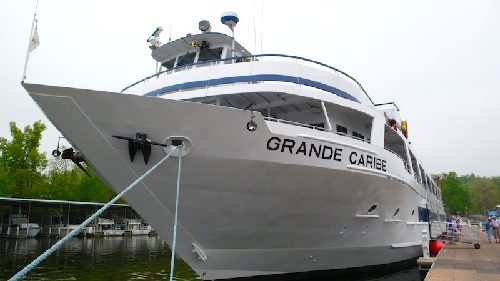How Oysters turned into Cruises.
Seems like the Blounts of Rhode Island had always been in the oyster business. The family oyster beds flourished. Workers were busy. Eager buyers lined up for the quality shellfish. Life was good.
Then came the 1938 hurricane. By the time the winds quit roaring and the seas stopped churning, E.B. Blount & Sons Oyster Company was devastated.
Studying at Wentworth College in Boston, son Luther Blount suddenly had no family business to return to. Instead, Luther came home and invented a process to steam clams that was so successful it soon was supplying ingredients for Campbell’s Soup clam chowder.
But Luther was troubled by the empty oyster processing plant that still sat untouched since the hurricane. Why not, he reasoned, use the family business site to build an oyster boat? So he did. Then he built another. And another. And another.
By 1964, Luther had built more than 100 vessels. He had even come up with a few boat patents that would lay the foundation for what is now Blount cruise ships.
Over the years, Luther built everything from dinner boats to ships that transported tourists around the State of Liberty in New York Harbor. An avid traveler, Luther also took his family and friends on boating excursions.
“Along the way, some of these people said, ‘Hey, you should start a cruise line.’ So he did,” said David Sylvaria, fleet captain for Blount Small Ship Adventures. “It just sort of grew from there.”
For his new cruise line in 1966, Luther wanted to build smaller ships that could travel to distant places that fit in with his simple motto: “Go where the big ships cannot.”
To make that possible, Luther used his engineering skills for several patented inventions. His patented bow ramp, for example, made it possible to walk directly from ship to shore, instead of being ferried by small ships into port.
His patented retractable pilot house – combined with the shallow draft (less than seven feet) of his ships – made it possible to cruise down narrow waterways, under low bridges and through places like the Erie Canal.
“Nobody runs through the Erie Canal except us,” Capt. David said. “We also travel in some really shallow waters where other ships can’t go.”
Even though Luther’s ships can hold 96 passengers, a crew, engines, glass bottom boats, kayaks and a whole lot more, Blount ships can clear obstacles that would stop other ships in their tracks.
After Luther’s death in 2006, his three daughters decided to change the name of the company. Formerly called American Canadian Caribbean Line, it is now Blount Small Ship Adventures.
“His daughters wanted to honor their father by using his name for the company,” Capt. David said.
Enjoying his 14th Blount cruise with his wife Judy, Fred Newton of Springhill, Florida, said he had the pleasure of meeting Luther Blount on one of his cruises.
“He was a very smart man and he loved to travel,” Fred recalled. “This was the way he liked to travel, on a small ship, and he made it possible for so many of us to do it, too.”
By Jackie Sheckler Finch
















View Recent Comments